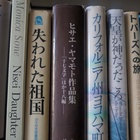Born in August 1921 in Redondo Beach, Southern California, Hisaye Yamamoto was one of the earliest Japanese American writers and gained national recognition as a short story writer in the postwar period.
Her parents were immigrants from Kumamoto Prefecture who grew tomatoes and strawberries in Southern California. Although she grew up in a rural Japanese community, she began writing in her teens and contributed to the Japanese newspaper "California Mainichi" before the war.
He studied at Compton College, majoring in French, German, Spanish, and Latin, and also attended a Japanese language school for 12 years. When the Pacific War began, he was sent to the Poston internment camp in Arizona with his family in 1942, where his articles and short stories were published in the camp's newspaper, the Poston Chronicle.
During the war, he moved to Massachusetts for a time, but returned to his family in an internment camp after one of his younger brothers was killed in action in Italy.
After the war, she worked for the black weekly newspaper, the Los Angeles Tribune, for three years, and was inspired by the ideas of the Catholic Worker, a peace movement and poor relief movement, and volunteered in New York for three years from 1953. She later married and had five children.
During this time he released works such as "Seventeen Syllables" (1949), "The Brown House" (1951), "Yoneko's Earthquake" (1951), and "Epithalamium" (1960).
She continued her creative endeavors while raising her children, and her works were published in Japanese newspapers and other publications. In Japan, some of her works were translated into Japanese in the 1980s, but it was not until 2008 that her works were published in book form: "Collected Works of Hisae Yamamoto - Seventeen Characters and 18 Other Stories" (translated by Iwao Yamamoto and Mie Hihara, published by Nagundo Phoenix). Three years after the publication of this book, Yamamoto passed away at the age of 89.
The book is based on "Hisaye Yamamoto, Seventeen Syllables and Other Stories. Introduction by King-Kok Cheung. Revised and expanded ed. (New Jersey: Rutgers University Press, 2001)," which was originally published by Kitchen Table Women of Color in 1988 and has been revised and updated with the addition of four new stories.
Hidden plot, restrained writing
As the title suggests, the book features 18 pieces published over the course of her life, from 1943 to 1995. In addition, it includes a comprehensive commentary by Kin-Kok Chan (Professor at the University of California, Los Angeles), who has been researching her work for a long time, as a preface.
In it, Professor Chang writes about the appeal of the work:
"Yamamoto dislikes bombastic rhetoric and combative language, but instead writes in a different way to appeal to us.... We must pay close attention to every word on the page in order to uncover hidden plots, gauge the characters' subdued feelings, and discern the author's silent criticism and obvious compassion."
Regarding the themes that the work deals with, the translator's afterword states, "there are three themes: interactions between diverse ethnic groups, the relationship between the first and second generation immigrants, and the difficult adjustment situation of the first generation immigrants in immigrant communities, particularly the oppression that first generation women faced."
The work is based on Yamamoto's life experiences from before the war. Being an immigrant and of Japanese descent. Getting caught up in the war and being put in an internment camp. Suffering from mental illnesses such as the problems black people face and alcoholism. Losing family. These are some pretty heavy experiences, but as Professor Chang says, the narration is calm and restrained, and at times the author's true intentions seem mysterious.
The long novel "Charlie in Las Vegas" seems to be based on her family history. She lost her brother in the war, but the protagonist's son is also killed in the war and we receive news of this. But these tragedies are told with ease.
The author's feelings are most clearly conveyed when he touches on issues related to racial discrimination. This does not only apply to white people against other races, but also to the discrimination he faces within himself. Although he is angry about the internment camp policy, Yamamoto himself makes his feelings clear about racial discrimination against black people in his "Revised and Expanded Edition":
"Our incarceration has come to seem insignificant compared to the slavery and prejudice that people have endured for nearly two hundred years."
Finally, this is a collection of short stories, so it would be best to read the detailed explanations in the preface later. Few people would start reading a novel with an explanation first.
(Titles omitted)
© 2017 Ryusuke Kawai







